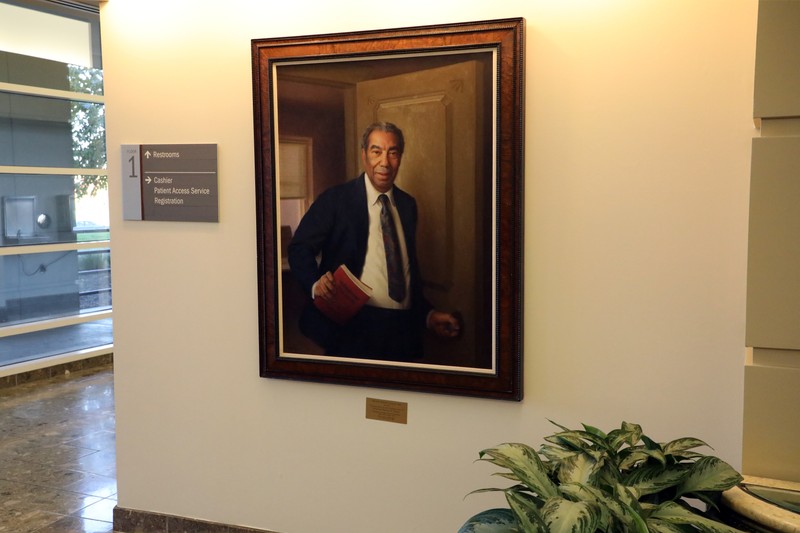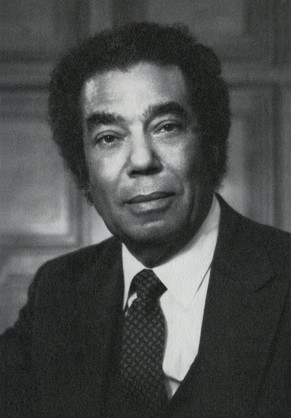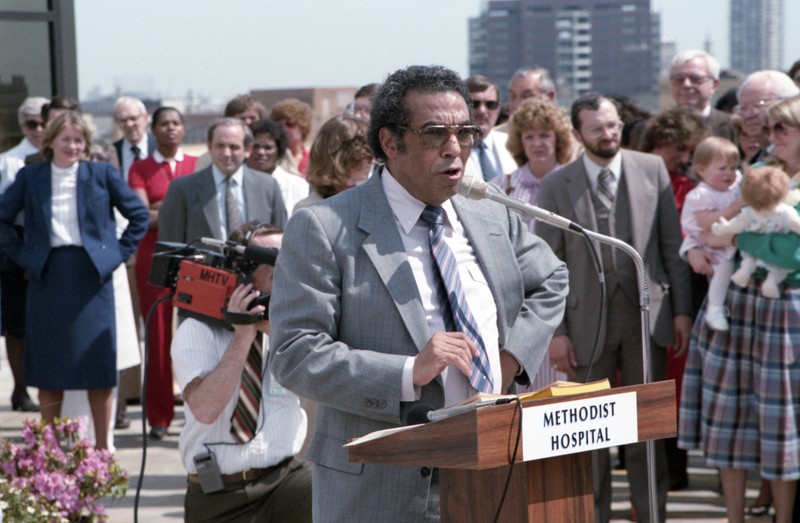Frank P. Lloyd Portrait
Introduction
Text-to-speech Audio
In 1990, the Methodist Hospital Board commissioned Michael Chelich to paint a portrait in honor of Dr. Frank P. Lloyd. In 1954, Dr. Lloyd helped break the integration barrier by being among the first three Black physicians hired at Methodist Hospital. In 1963, he was promoted to director of the Medical Research Department. During his leadership, the department made pivotal medical advancements. Because of his successful leadership in medical research, he became the president of the hospital in 1981. In his seven years as president, he guided the hospital through major expansion programs and solidified the hospital's footprint in downtown Indianapolis.
Images
Frank Lloyd Painting

Frank Lloyd

Frank Lloyd speaking at West Tower topping off ceremony

Backstory and Context
Text-to-speech Audio
In 1948, the Methodist Hospital Staff Council established a policy opening employment up to any qualified physician regardless of race, color, or creed. However, it was not until 1954 that the first Black physicians joined the staff and until 1956 that the first Black student graduated from the Methodist Hospital School of Nursing. Near the same time as staff integration, the hospital began the process of patient integration. Until the mid-1950s, Black people and other minorities could only gain access to City Hospital (later named Wishard Hospital and now known as Eskenazi Hospital) unless they were from outside Marion County. To force integration, the Indianapolis Hospital Development Association (IHDA) tied financing for expansion to integration in 1951. Officials from the IHDA claimed that money for expansion was being solicited from all people; therefore, it was unfair that some people were providing expansion money, but still refused medical care. This was a major triumph for members of the Indianapolis Black community who were living in an area that was dominated by the Klu Klux Klan in the 1920s and subject to de facto segregation in most areas of life.
Dr. Frank Lloyd was a native of Charleston, South Carolina. He received his degree from the Howard University College of Medicine. He held an internship at Freedman’s Hospital in Washington D.C. before being named a Rockefeller Fellow at Columbia Presbyterian Medical Center in New York. Later he became a teacher at Columbia University. In 1952, Dr. Lloyd and his wife Daisy Riley relocated to Indianapolis as the city’s IHDA integration policy was attractive to them. Two years later, along with Dr. Harvey Middleton and Dr. E. Paul Thomas, he was one of the first Black physicians admitted to the Methodist staff. In 1963, Dr. Lloyd was promoted to Methodist’s first full-time director of medical research. Under Dr. Lloyd’s leadership the department of Medical Research was in the forefront of developments in medicine. One of the department’s most notable accomplishments was being a pioneer in the uses of artificial kidneys.
Because of his effective leadership in the Medical Research Department, when Jack Hahn stepped down as superintendent and president of Methodist Hospital in 1981, Dr. Lloyd stepped into his role. Dr. Lloyd was the logical successor of Hahn due to his knowledge of and experience in city and community planning, medical science, and business. Before assuming the presidency, Dr. Lloyd was an integral member of the committee that planned Methodist Hospital’s downtown expansion. The expansion plan unfolded in several phases, beginning with the facilities center in 1982, before moving to the construction of the A building West and East. The expansion solidified Methodist Hospital’s commitment to staying near downtown Indianapolis.
Upon assuming his new duties on April 1, 1981, Dr. Lloyd began a comprehensive review of corporate programs and policies. He wanted to approach new strategies to address national economic and governmental changes that affected healthcare while still providing excellent service to Indianapolis and beyond. As a result, Methodist Hospital established a new strategy that called both horizontal and vertical integration for more rapid adjustment to unpredictable market forces. Furthermore, Dr. Lloyd’s review identified 14 important service lines in the hospital. Out of the 14 service lines studied by Dr. Lloyd, five emerged as areas of prime emphasis for growth: cancer care, cardiovascular care, eye care, neurological care, and trauma care. During his tenure as president, Dr. Lloyd saw his strategy start to take effect resulting in major building expansions, medical science advancements, and continued quality medical care for Indianapolis citizens. Dr. Lloyd retired from the presidency in 1988, and William Loveday succeeded him.
For his over 30 years of service at Methodist Hospital, Dr. Frank Lloyd was held in high regard for his leadership. As a result, in 1990 William Loveday commissioned local artist Michael Chelich to paint a portrait of Dr. Frank Lloyd. The oil portrait hangs in the main lobby of the A building as a testament to his lifetime of leadership and central role in guiding Methodist Hospital’s growth and development.
Sources
Reed, Kenneth E. and Leary, Edward A. A History of Methodist Hospital of Indiana Inc.: A Mission of Compassionate Heath Care. Indianapolis, IN, 2007 https://indianamemory.contentdm.oclc.org/digital/collection/HIUH/id/556
Newspapers Consulted:
Indianapolis Star
Indianapolis News
Materials in IU Health Archives Consulted:
Board and Committee Minutes
The Beacon Newsletter
IU Health Archives
IU Health Archives
IU Health Archives
